|
| |
|
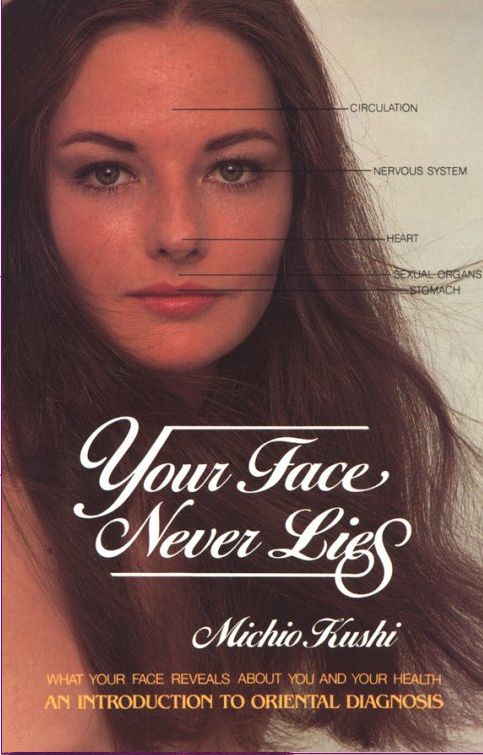
 |
Your Face
Never Lies
An Introduction to Oriental Diagnosis
by Michio Kushi
From
the Preface by Michio Kushi:
Accurate diagnosis is a key factor
in the treatment of any illness. Modern medical diagnosis often employs
techniques like surgery, the administration of dyes and radioactive fluids,
and X-rays, all of which can actually harm the patient. Moreover, these
sophisticated forms of diagnosis look only at the body, its function, and
its physiology, while attempting to pinpoint the cause of the problem. The
person's overall health, mental state, and lifestyle are completely and
quite mistakenly overlooked.
Oriental diagnosis views the total
person, physically and mentally, as well as the troubled organs or body
parts. The practitioner interprets the person's lifestyle and social and
environmental surroundings to arrive at the cause and cure of the problem.
I sincerely hope that this
introductory book will stimulate further study. Through regaining a
sensitivity to your own body and better understanding the health of your
loved ones, friends, and associates, you can learn to recognize the signs of
physical illness and prevent—even
reverse—its development, while restoring vibrant health. |
|
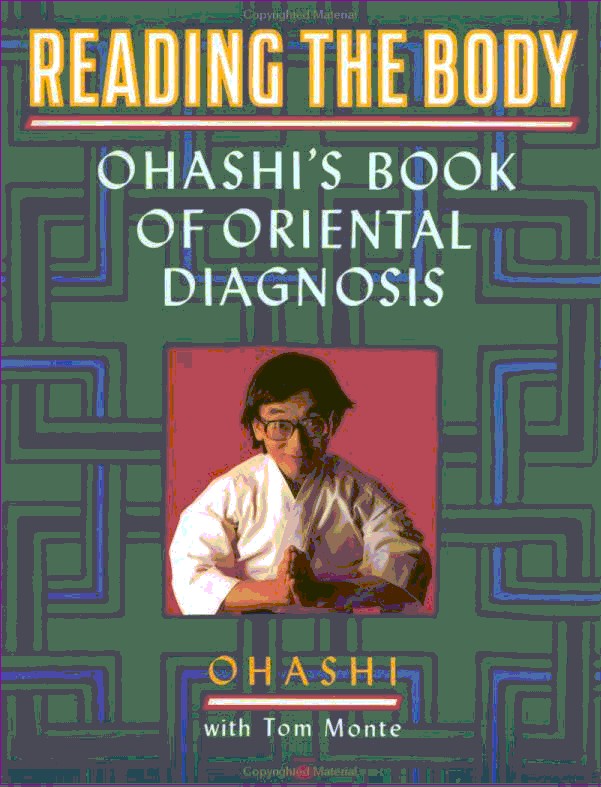
 |
Reading
the Body
Ohashi's Book of Oriental Diagnosis
by Ohashi with Tom Monte
People are always asking me, “How
can I be happy?” Or, “How
can I find the thing I really want to do in life?”
I tell them, You are standing on your answer. The secrets of life are
written on your body.
—Ohashi
Ohashi helps you learn these
secrets by showing you how to read your body to determine both your physical
and spiritual condition as revealed in the physical self. Because, as Ohashi notes,
“the body is the physical manifestation of the soul,”
your posture, your features, and the texture of your skin can tell you who
you are.
This is not a book about health and
shiatsu; it is a guide to living well. The goal of Oriental diagnosis
is to find unity of body, mind, and spirit. It emphasizes that
everyone has strengths and weaknesses and that accommodation one's
weaknesses is as important as utilizing one's strengths.
Filled with diagrams, drawings, and
sample diagnoses, this is not only a practical guidebook—by reading the
body one can tell what shiatsu techniques to apply to the various energy
meridians of the body—but also a fascination meditation on how to live. |
|
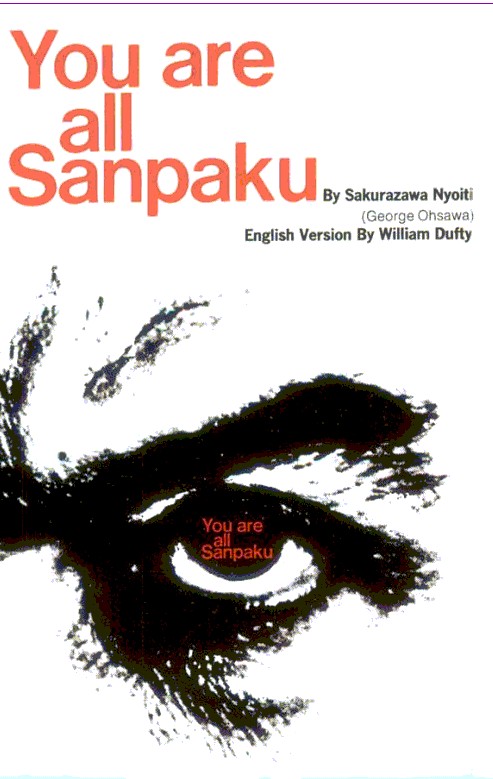
 |
You Are
All Sanpaku
by George Oshawa
From Amazon.com
This book introduced two new words into our vocabulary. The
first, a well-known Japanese term, sanpaku, describes a condition in which
the white of the eye can be seen between the pupil and the lower lid as the
subject gazes directly forward. This, we quickly learn, connotes a grave
state of physical and spiritual imbalance. The sanpaku is out of touch with
himself, his body and the natural forces of the universe. Symptomatically,
sanpaku can be recognized by chronic fatigue, low sexual vitality, poor
instinctive reactions, bad humor, inability to sleep soundly and lack of
precision in thought and action. Macrobiotics, our second term (and one
which quickly became part of the English language) is the simple, natural
means of correcting the dangerous sanpaku condition and creating a state of
health, harmony and well-being, within and without. Based philosophically on
the ancient Oriental concept of Yin-Yang forces in the universe, and
biochemically on the important relationship between sodium and potassium in
the body, macrobiotics has been known and practiced in the Far East for many
centuries.
The macrobiotic diet, the author claims, not only cures
existing ills but fortifies the body against disease. And macrobiotics has
been welcomed by weight-watchers as a means to rapid weight loss. |
|
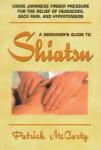

|
A
Beginner's Guide to Shiatsu
Using Japanese Finger Pressure for the Relief of
Headaches, Back Pain, and Hypertension
by Patrick McCarty
The art of shiatsu—also called
acupressure massage—is an Eastern technique of healing and relaxation that
has been successfully used for centuries. In Japanese, the word shi
means finger and astu means pressure. Based upon the idea that
channels of energy flow through the body, shiatsu was developed to keep
theses channels flowing freely to maintain maximum health.
Patrick McCarty's book, The
Beginner's Guide to Shiatsu, is a concise guide to the basics of
shiatsu. McCarty clearly explains what shiatsu is, how it came about,
why it is used, and how it is used. Using easy-to-follow
illustrations, the author shows you how to relieve headaches, back pain,
stress, and other common ailments. In addition, he provides a simple system
of diagnosing possible organ problems, and offers nutritional
guidelines based upon the macrobiotic diet.
When done properly, shiatsu is a
safe and effective means for easing pain. It can also create a feeling
of well-being, vitality, and relaxation. It requires no special
equipment, and it can done anywhere, at any time. Let The
Beginner's Guide to Shiatsu introduce you to this time-honored practice. |
|
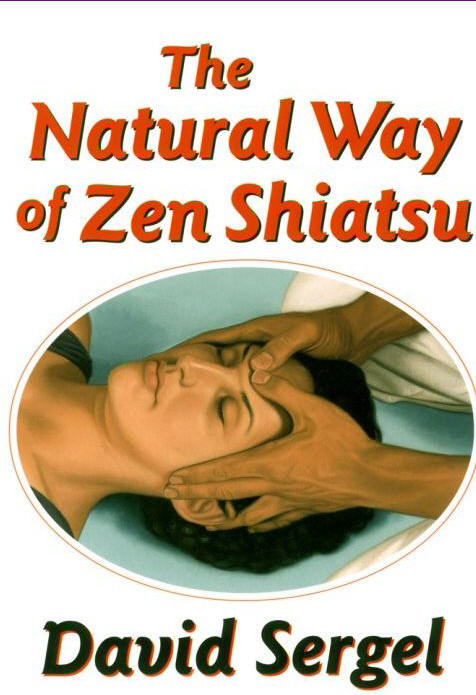
 |
The
Natural Way of Zen Shiatsu
Finger Pressure Massage for Diagnosis and Treatment
by David Sergel
From
Chapter 1:
Shiatsu, or finger pressure,
evolved in Japan in the 1900's from Anma, a style of massage imported from
China centuries earlier. While its deepest roots in an instinctive
application of pressure to relieve areas of bodily pain, the theoretical
base of shiatsu is classical Chinese medicine. Zen Shiatsu also reflects the
cultural background of Japan, permeated by the philosophy of Zen Buddhism. Shizuto Masaunaga created and developed this style throughout a thirty year
career until his death in 1981.
Macrobiotics, or life embracing the
"largest view," is a practical philosophy based on the ways common to
traditional people. As it is popularly known, macrobiotics was first
introduced from Japan by George Ohsawa, a teacher, poet, philosopher, and
world traveler, who began teaching in Europe in the 1930's. The ultimate
goal of macrobiotic practice is the attainment of absolute freedom.
The compass to reach this goal is an intimate understanding of the forces of
yin and yang: a comprehension of an order common to all aspects of the
infinite universe. The foundation of this freedom lies in our daily diet.
Since the same cultural soil gave
form to both shiatsu and macrobiotics, we might expect to see strong
possibilities of a harmonious integration between the two. In fact as we
delve deeper, we see evidence that shiatsu arose from a macrobiotic mind and
is thus according to this view, from its foundation, a macrobiotic practice. |
|
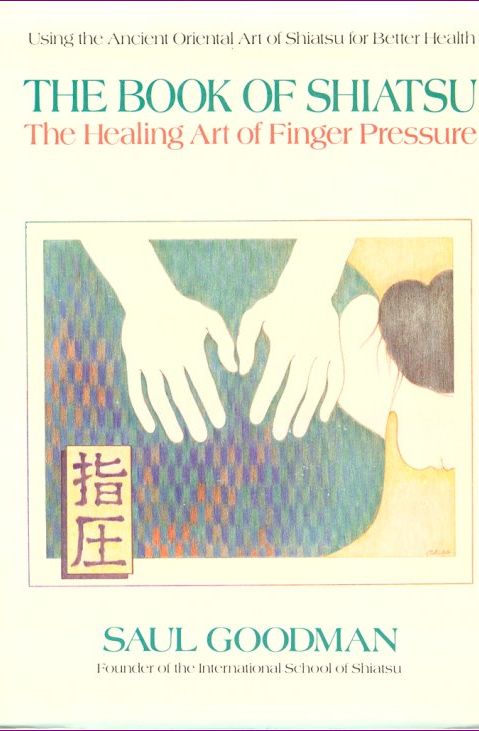
 |
The Book of Shiatsu
The Healing Art of Finger Pressure
by Saul Goodman
From
the Preface:
There are many speculations as to
how and when shiatsu began. Some claim that it is 5000 years old; others say
that it is only 100 years old As we begin to realize the essence of shiatsu,
we realize that it is timeless. Shiatsu's origin is an outgrowth of the
order of nature expressed in a fundamental human exchange. This order is
simply the process of making balance, which is the primary activity of all
life. In this sense shiatsu goes on mechanically in the environment, in the
check and balance of the animal, vegetable, elemental, and energetic worlds,
and within all of the spheres of human life. It goes on within our body
balances of acid and alkaline, temperature regulation, read and white blood
cell maintenance, in the balancing of sugar levels, hormones, etc. It goes
on within our senses, emotions, and intellect, as well as socially and
ideologically.
The art of shiatsu, practiced to
create a balance of energy, is an innate part of being human. It employs the
use of our hands as an extension of our heart and as an expression of our
compassion. because this ability is so commonly based, everyone has the
ability to give effective shiatsu. Experience in teaching has found this to
be true. Shiatsu connects us with something essential to life and is primary
to the development of our health and happiness. We intend this manual to
assist everyone in bringing forth their shiatsu. |
|
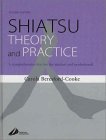
 |
Shiatsu
Theory and Practice
A Comprehensive Text for the Student and Professional
by Carola Beresford-Cooke
This book provides a clear and
complete introduction to the theory and practice of Zen Shiatsu, presenting
vivid detail on the theoretical foundations of both Traditional Chinese
Medicine and five element theory. It offers remarkably clear, high-quality
illustrations and photos that support text discussions. The all-encompassing
2nd Edition takes the reader through an exploration of the various
approaches to treatment routines, with case studies, explanations, and
step-by-step descriptions of techniques.
From a reviewer on Amazon.com
Last year I graduated from the
International School of Shiatsu in Doylestown, Pennsylvania. Prior to this
school, I attended another Shiatsu school as well. Through both schools, I
used this book as my main reference. I highly recommend it to anyone
studying this wonderful art. It has all the detailed meridians—both
standard and "Zen"—and
extensive info on the 5 elements. Buy it ... you'll love it! |
|

 |
Back Pain
Chinese Qigong for Healing and Prevention
by Dr. Yang, Jwing-Ming
Relieve your back pain naturally,
without drugs or surgery. For centuries the Chinese people have healed and
strengthened their bodies with Qigong (Chi Kung), the Chinese science of
manipulating Qi (vital energy). Now, you can learn these gentle Qises and
soothing massage techniques to help ease your lower back pain, strengthen
your torso, prevent future back problems, and promote improved Qi and blood
flow to expedite your body's natural healing abilities.
This text explains how to heal back
problems with qigong techniques that employ partner-based massage and
self-healing methods. Over 100 clear photos visually complement the text.
The author gives a thorough description of the anatomy of the back and its
relation to the rest of the body. The therapeutic exercises are reminiscent
of tai chi; they are simple and easy enough for anyone to do at any time of
the day. The massage techniques are clearly explained, and they enable
virtually everyone to use their qi to give a healing back massage. |
| |
|

|
